Government Forces Attack Iranian Mourners In Tabriz
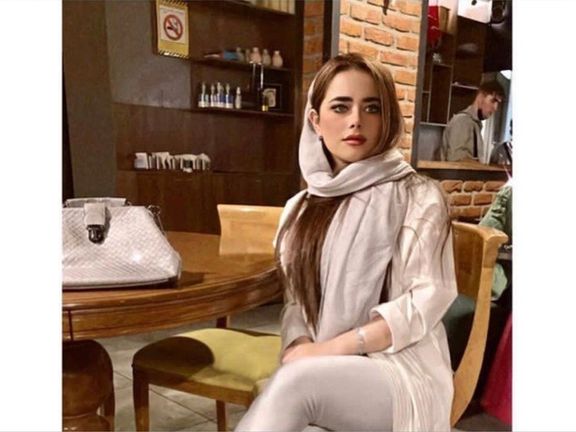
Security forces have attacked people attending the funeral ceremony of a 23-year-old woman who was killed by regime forces in the northwestern city of Tabriz.

Security forces have attacked people attending the funeral ceremony of a 23-year-old woman who was killed by regime forces in the northwestern city of Tabriz.
People chanted slogans at the clerical regime during the burial ceremony of Aylar Haqqi on Friday morning in the presence of a large crowd of mourners in Tabriz cemetery.
Aylar Haqqi, a medical student had reportedly taken refuge in a building during Wednesday demonstrations, where the regime agents found her and pushed her from the top of the building. A rebar pierced through her abdomen and out from her back. However, the regime announced she had died after falling into a construction dig.
Meanwhile, some sources quote a relative of Aylar saying she has been killed by direct fire of security forces, but in order to deliver her body to her parents security agents forced them to say she died after falling from top of a building.
Reports on social media say another young person named Ali Araghi was also killed in Tabriz on Wednesday night.
Meanwhile, an anonymous group called Freedom-seeking Revolutionaries of Azarbaijan in a statement called on people in all cities of the province to take to streets every day beginning Friday.
According to Iran Human Rights Organization, security forces had killed at least 342 people, including 43 children and 26 women as of Wednesday. There is no new estimate for the past two days of intense protests.
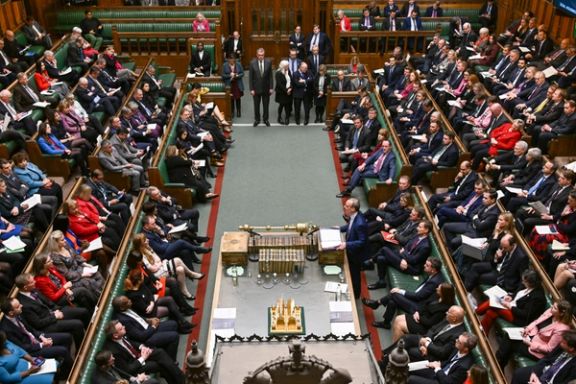
Iran was a hot topic at a session of the UK House of Commons Wednesday with many lawmakers concerned about the impending executions of detained prisoners.
A wide range of Iran-related topics were discussed during the session, including how the UK can help support the protesters, prevent the Islamic Republic from another round of mass executions like the ones in 1988, and how to deal with the threats posed by Iran’s Revolutionary Guard both in the region and inside the UK.
The threats against Iran International and BBC Persian journalists were also mentioned by Conservative MP Bob Blackman, Shadow Minister for the Middle East and North Africa Bambos Charalambous, Parliamentary Under-Secretary of State for Americas and Caribbean David Rutley, and Shadow Minister of State for Security Holly Lynch.
The MPs were concerned that President Raisi, who is one of the main culprits behind the 1988 prisoner massacre that led to the killing of thousands, will orchestrate a similar carnage in cooperation with the IRGC and the judiciary.

The MPs referred to the death sentences handed to several protesters this week and expressed concerns that a similar fate will be expected for a large number of protesters, particularly following a call by 227 Iranian parliamentarians who are pushing for the death penalty. Moreover, calls for proscription of the IRGC are getting stronger in the British political sphere as they are the main force that would go on with the purge.
So far, nearly 400 protesters have been reported dead – including about 50 children – and over 15,000 have been detained since the current wave of protests engulfed Iran following the death in custody of 22-year-old Mahsa Amini, it was said. However, the figures are likely much higher, but the authorities do not release any data and obscure the ways for human right groups to obtain information.
Blackman said, “Contrary to the reports that the Minister mentioned, the reports I have are that more than 60,000 people have been arrested.” He added that “President Raisi, was responsible as the prosecutor in Iran for 30,000 executions of political prisoners in 1988, so the direction from the top is very clear... We are also aware that sentencing and executions are beginning in Iran, and that many thousands of people may end up being executed.”
Rutley argued that the threats to press freedom in Iran, now extended to the UK, were a sign of the regimes growing weakness in the face of ‘grassroots’ protests.
Describing the level of violence against protesters as “utterly appalling,” Rutley said, “The UK opposes the death penalty in all circumstances, but it is all the more abhorrent when those sentenced are being arrested for standing up for their rights.”
He added that “the frequency of these death sentences is only likely to increase as the regime processes the thousands of arrests that have been made during the protests. The Iranian judicial system is notorious for its lack of transparency and process, and this barbarism is just one of many threatening and intimidating techniques that the regime has rolled out in response to the protests.”
Blackman was another MP that asked the government to proscribe the IRGC as a terrorist group, but Rutley reiterated the government’s position of not commenting on potential proscriptions.
Speaking on behalf of the opposition, Charalambous and Lynch asked about the steps the UK Government is taking to protect journalists and UK nationals critical of the regime. In response, Rutley reiterated his previous points about summoning the Iranian Chargé d’affaires and the support being provided by the police.
Citing a report from MI5 of 10 assassination attempts on British residents this year, Lynch called for measures to remove the Islamic Republic-linked actors from the UK
She also asked what steps the government was taking to remove actors linked to the Iranian government from the UK citing a report from MI5 of 10 assassination attempts on British residents this year. Rutley’s response cited the Foreign Secretary’s warning to the Islamic Republic’s chargé d’affaires and promised that the Government would continue to monitor the situation.
Other contributors to the debate repeated Bob Blackman’s request about the need to proscribe the IRGC and for the Government to do more to support the protesters. Rutley’s responses made clear the Government’s support for the protesters, but they did not announce much by way of new measures.
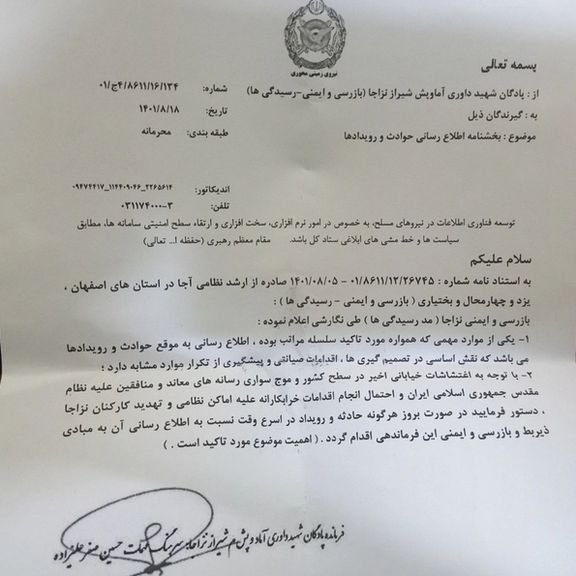
A new document received by Iran International shows that Iranian Army staff and their families have been supporting the popular antigovernment protests since September.
In a letter issued by a high-ranking army commander, he demanded daily reports on the arrest of army personnel and their families during protests, as well as paying attention to "subversive actions" against military facilities.
Hossein Safaralizadeh, commander of an army base in the southern city of Shiraz, has also mentioned that the army’s inspectorate has also warned other commanders in three provinces of Esfahan, Yazd and Charmahal-Bakhtiari to follow up on such cases on daily basis.
This letter may suggest that the number of army personnel who are showing sympathy toward the protest movement, or family members participating in protests is on the rise and top military officials are concerned about it.
“The presence of army personnel and their families in riots, their arrest by the security, writing anti-government slogans on the walls of the barracks, and the amount of possible damage to the barracks and army housing units must be reported daily… through text, phone, or reports,” reads the letter.
Iran’s traditional Army, as distinct from the Revolutionary Guard, is widely criticized for not acting against the brutality of Basij militiamen, IRGC forces, and police who are ruthlessly killing innocent people during the uprising.
Analysts believe that, in the past years, the Islamic Republic has provided key positions of the army to the members of the Revolutionary Guard to eliminate the possibility of forming an opposition within the army.

Thursday was the third day of pre-announced nationwide protests in Iran, with numerous mourning ceremonies held for those killed in recent days.
In the past three days, the grassroot nature of the protests manifested itself in small towns, where people were almost unstoppable and brought the security forces to their knees.
Government forces have killed nearly 350 people since the protests began following the death in custody of 22-year-old Mahsa Amini in mid-September, and each death has fueled more protests since holding mourning ceremonies and funeral services is culturally important for Iranians.
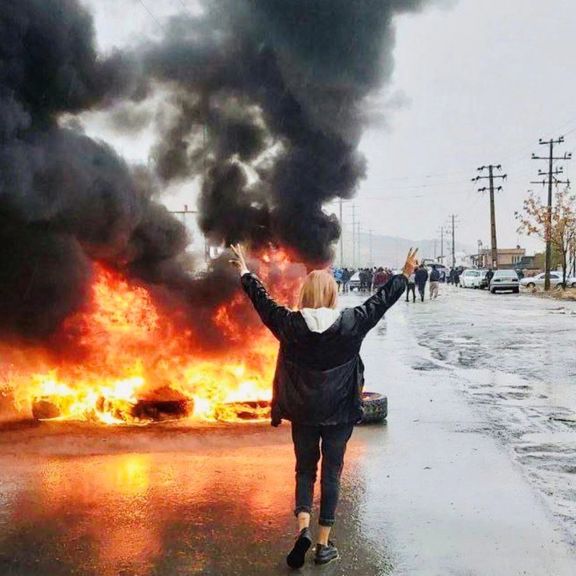
No day passes without some event in honor of one or more protesters in cities across Iran. In addition, hundreds of families also hold ceremonies for their loved ones who were killed three years ago during the November 2019 unrest when security forces began firing at people from the first day of protests, killing at least 1,500 citizens. Every one of these ceremonies is an opportunity for people to hold gatherings and express their resentment against the regime. Thursday was no exception as many funerals and mourning gatherings morphed into protest rallies.
Another new low for the clerical regime is killing children, whose deaths enrage Iranians even more and their funerals and mourning ceremonies bring out larger crowds. According to human rights groups, over 40 children were already killed by government agents until this week when security forces killed several more. Some children take part in the protests but many simply happen to be in the wrong place at the wrong time, when riot police or government vigilantes open fire.
Mourning ceremonies for a 10-year-old boy in the city of Izeh, in Khuzestan province, was one of the main events of the Thursday protests in several cities, as social media exploded with depictions inspired by his death.
In addition to pockets of protests in large cities, which have been scenes of protests and clashes during the past two months, more protesters turned out in towns with less than 50,000 population, blocking streets, chanting antigovernment slogans and setting fire to government buildings.
Law enforcement forces in small cities normally tend not to respond violently to the protesters because people in such cities usually know each other’s families. Many of the people who are now members of Basij paramilitary forces are cracking down on people who used to be their classmates or neighbors while they were growing up. Therefore, the regime transfers forces from other cities, but the strategy is only partially useful because outside forces do not know the localities as well as its residents, so they are easily outsmarted by the protesters, making towns fall under the control of the people.
On Thursday, some towns were scenes of clashes that earlier were not hotbeds of protests. Semirom and Khorasgan in Esfahan province, Paveh and Sarpol-e Zahab in Kermanshah, Khomein in Markazi Province, Eyvanki in Semnan, Khonj in Fars, Qorveh in Kordestan, Khoy in West Azarbaijan, Sarableh in Ilam, and Masal in Gilan were some of the small cities and towns whose residents held remarkable protest rallies on Thursday.
The cities that have become well-known for the bravery of their citizens were also among the places of biggest demonstrations. People on social media say Sanandaj witnessed its largest rally in the past two months.
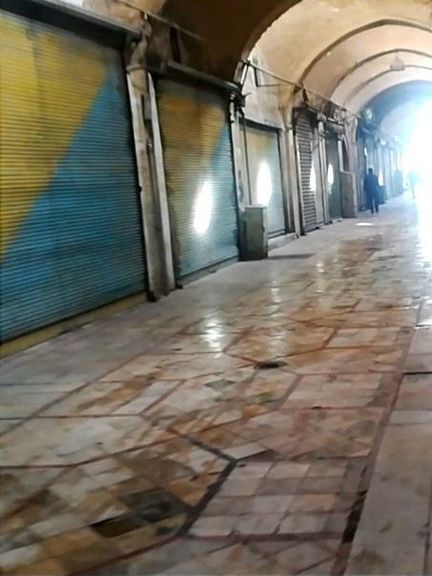
Small businesses in Iran are still on strike for the third consecutive day with shops kept closed in different cities to show solidarity with the uprising against the Islamic Republic.
Reports say bazaars and markets of Tehran, Mashhad, Kermanshah, Shiraz, Arak, Qazvin, Kerman, and many other cities were closed on Thursday.
Workers in some large government-owned companies, such as steel and oil producers are also on strike.
Massive strikes come in response to calls published on the anniversary of the massacre of protesters in November 2019.
A series of nationwide protests in Iran, sometimes known as Bloody November, took place in 2019. Initially triggered by a 50 to 200-percent increase in fuel prices, the demonstrations quickly turned into calls for the overthrow of the government and Supreme Leader Ali Khamenei. According to a report by a rights group, at least 3,000 protesters were killed by the Islamic Republic security forces from November 15 to 17, and nearly 20,000 arrested. Reuters at the time reported 1,500 deaths.
Grassroot groups last week called for protests across the country for November 15, 16, and 17.
Videos from the western city of Bukan show that people held a protest rally in front of the municipality of the city on Thursday after the funeral of Mohammad Hassanzadeh and Salar Mojaver, who were killed by regime forces Wednesday. There have also been reports that people attacked the municipality building.
According to reports, security forces attacked people during the funeral ceremony firing live rounds and tear gas.
In Sanandaj, the capital of Kordestan province, the protesting people also gathered at a cemetery to mark the fortieth day after the death of some demonstrators chanting slogans such as “Death to the dictator”.

The UN’s Third Committee has approved a draft resolution on Iran’s human rights situation, expressing concern at the alarmingly high frequency of the death penalty in the country.
The motion was ratified by a recorded vote of 80 in favor to 28 against, with 68 abstentions on Wednesday [Nov. 16]. The committee, which deals with human rights, humanitarian affairs and social matters, meets every year in early October and aims to finish its work by the end of November.
The United Nations General Assembly Third Committee -- also known as the Social, Humanitarian and Cultural Committee or C3 – also approved four other resolutions on Myanmar, Syria, North Korea, Crimea and one about the refugees and displaced persons in Africa.
In the resolution on Iran, the committee urged the Islamic Republic to cease the use of excessive force against protesters, who have been holding daily rallies across the country since Mahsa Amini’s arbitrary arrest and subsequent death while in ‘morality’ police custody.
According to Canada’s representative, despite “deplorable actions by Iranian authorities against protesters, mass peaceful protests continue into their eighth week,” noting that the killing of Mahsa Amini is just one instance of human rights atrocities in Iran. He added that “violent implementation of the hijab and chastity laws undermine the human rights of women and girls.”
Calling for accountability, he expressed deep concern over the authorities’ use of force, as well as the increasing use of the death penalty. He pointed to the systemic prosecution of minorities, alarming restrictions on the Internet and mobile data, and the generalized use of arbitrary detentions and enforced disappearances.
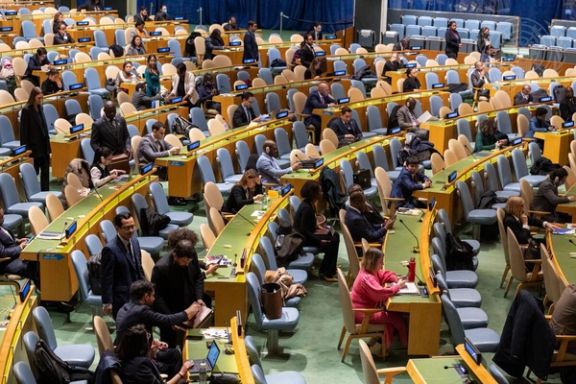
The Australian representative also condemned the disproportionate use of force against protesters and called on the Islamic Republic to establish a moratorium on all executions and to cease its long-standing oppression of the LGBTI community and its discrimination against ethnic and religious minorities. “Sovereignty is not a shield” for human rights violations, she added.
The UK representative described the death of Mahsa Amini “a shocking reminder of the oppression faced by women in Iran,” condemning the enforcement of the hijab and chastity laws by the so-called morality police. He also voiced concern over the situation of 14,000 arrested protestors and the death sentences. Expressing support for the UN Human Rights Special Rapporteur’s work on Iran’s oppression of minority groups and media freedom, he said “the Iranian people have suffered enough.”
The US envoy highlighted the deteriorating human rights situation in Iran since last year and recalled listening to experts tell of egregious violations during a recent Security Council meeting. Detailing the torture of activists and protestors as well as recent death sentences, she said that Iran obscures its acts by limiting access to the Internet, intimidation and refusing access to the Special Rapporteur. She described the resolution as a message of support to the Iranian people and welcomed the specific language on the death of Mahsa Amini.
Rejecting the draft, the Islamic Republic’s delegate denounced the co-sponsors -- including Canada, the United States, the United Kingdom, Israel and Germany. She claimed that women and girls in Iran are fully aware of their rights and how to interact with the government, adding that there is no need for Western countries to advocate for them. She made the remarks while around 350 Iranian protesters have been killed in the current wave of protests and about over 14,000 have been detained with the judiciary sentencing several of them to death in sham trials.
The UN Human Rights Council will also adopt a resolution aimed at holding the Islamic Republic accountable on November 24.